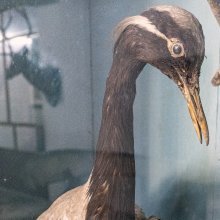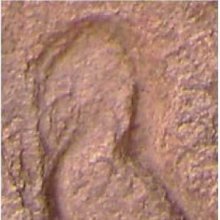Crane: 2 definitions
Introduction:
Crane means something in Buddhism, Pali, Hinduism, Sanskrit. If you want to know the exact meaning, history, etymology or English translation of this term then check out the descriptions on this page. Add your comment or reference to a book if you want to contribute to this summary article.
Images (photo gallery)
In Hinduism
Natyashastra (theatrics and dramaturgy)
Source: Shodhganga: Elements of Art and Architecture in the Trtiyakhanda of the Visnudharmottarapurana (natya)The Crane (animal) is associated with Bhramara-hasta: one of the twenty-two Single-hand Gestures (in Indian Dramas) (known as asaṃyuktahastas), according to the Viṣṇudharmottarapurāṇa, an ancient Sanskrit text which (being encyclopedic in nature) deals with a variety of cultural topics such as arts, architecture, music, grammar and astronomy.—The name of the posture bhramara itself identifies the shape of a bhramara i.e., a black bee. Abhinavagupta also admits it. [...] In the Abhinayadarpaṇa, this posture is said to denote bee, parrot, wing, crane, cuckoo etc.

Natyashastra (नाट्यशास्त्र, nāṭyaśāstra) refers to both the ancient Indian tradition (shastra) of performing arts, (natya—theatrics, drama, dance, music), as well as the name of a Sanskrit work dealing with these subjects. It also teaches the rules for composing Dramatic plays (nataka), construction and performance of Theater, and Poetic works (kavya).
In Buddhism
Tibetan Buddhism (Vajrayana or tantric Buddhism)
Source: academia.edu: The Structure and Meanings of the Heruka MaṇḍalaThe Crane is associated with the Yoginī (female deity) named Bakī, being situated in the Vāyucakra, according to the 10th century Ḍākārṇava-tantra: one of the last Tibetan Tantric scriptures belonging to the Buddhist Saṃvara tradition consisting of 51 chapters.—Accordingly, the vāyucakra refers to one of the three divisions of the dharma-puṭa (‘dharma layer’), situated in the Herukamaṇḍala. The 36 pairs of Ḍākinīs [viz., Bakī—“Crane”] and Vīras are dark blue in color; they each have one face and four arms; they hold a skull bowl, a skull staff, a small drum, and a knife.

Tibetan Buddhism includes schools such as Nyingma, Kadampa, Kagyu and Gelug. Their primary canon of literature is divided in two broad categories: The Kangyur, which consists of Buddha’s words, and the Tengyur, which includes commentaries from various sources. Esotericism and tantra techniques (vajrayāna) are collected indepently.
See also (Relevant definitions)
Query error!
Full-text (+364): Sarasa, Baka, Balaka, Vaka, Karayika, Majjika, Manitaraka, Kraunca, Pingalika, Sarpabhuj, Markata, Karatu, Sarasika, Vakota, Kurankara, Kahva, Lakshmana, Sarotsava, Shuklavayasa, Shatapatra.
Relevant text
Search found 145 books and stories containing Crane, Cranes, The crane; (plurals include: Cranes, Craneses, The cranes). You can also click to the full overview containing English textual excerpts. Below are direct links for the most relevant articles:
Animal Kingdom (Tiryak) in Epics (by Saranya P.S)
Chapter 4.29 - The Kraunca (Demoiselle crane) in the Epics
Chapter 4.32 - Water-loving birds in the Epics
Chapter 4.20 - Animals and birds in the epic Ramayana (Introduction)
Jataka tales [English], Volume 1-6 (by Robert Chalmers)
Jataka 38: Baka-jātaka < [Book I - Ekanipāta]
Jataka 236: Baka-jātaka < [Book II - Dukanipāta]
Jataka 279: Satapatta-jātaka < [Book III - Tika-Nipāta]
Yoga Vasistha [English], Volume 1-4 (by Vihari-Lala Mitra)
Chapter CXVIII - Description of deer, peacocks, cranes &c < [Book VII - Nirvana prakarana part 2 (nirvana prakarana)]
Chapter II - Rama’s recapitulation of vasishtha’s lectures < [Book V - Upasama khanda (upashama khanda)]
Chapter LXIV - Sport of the heavenly nymphs < [Book VII - Nirvana prakarana part 2 (nirvana prakarana)]
Hitopadesha (English translation) (by Sir Edwin Arnold)
Chapter 7 - The Story of the Crane and the Crab < [Book Four - Peace]
Chapter 2 - The Story of the Weaver-Birds and the Monkeys < [Book Three - War]
Chapter 5 - The Story of the Herons and the Mongoose < [Book Four - Peace]
Dhammapada (Illustrated) (by Ven. Weagoda Sarada Maha Thero)
Verse 126 - The Story of Venerable Tissa < [Chapter 9 - Pāpa Vagga (Evil)]
Verse 155-156 - The Story of Mahādhana the Treasurer’s Son < [Chapter 11 - Jarā Vagga (Old Age)]
Mahabharata (English) (by Kisari Mohan Ganguli)
Section CLXLVIII < [Markandeya-Samasya Parva]
Section CLXXI < [Apaddharmanusasana Parva]
Section CCV < [Markandeya-Samasya Parva]

